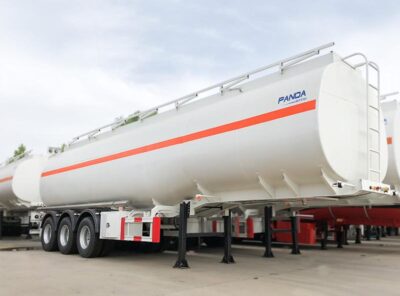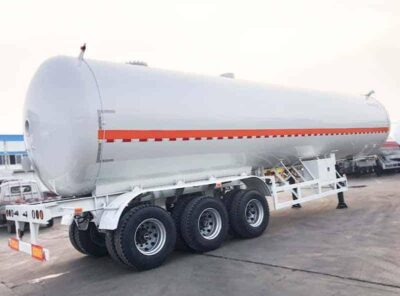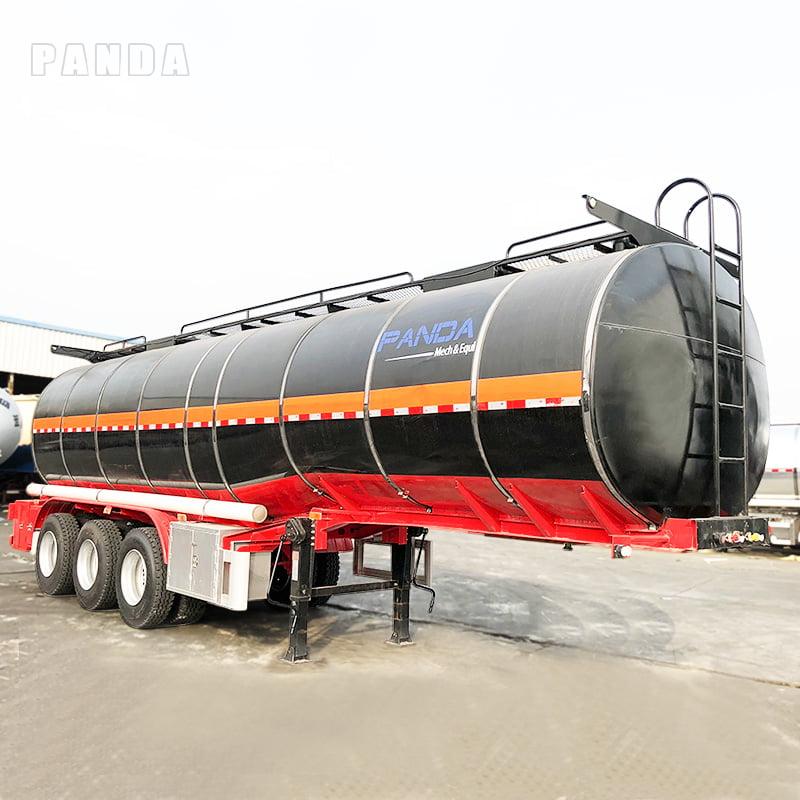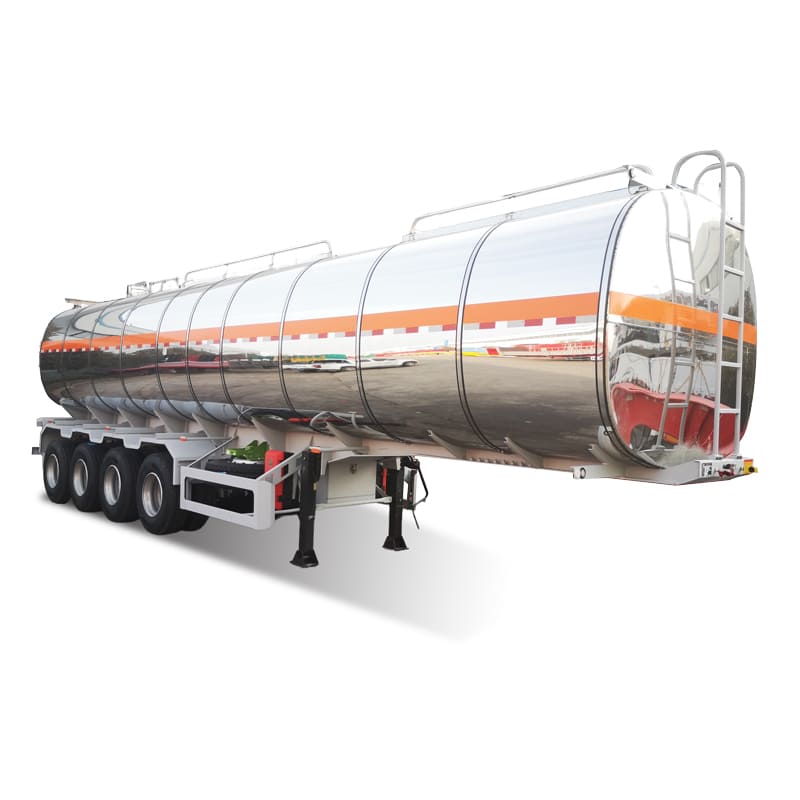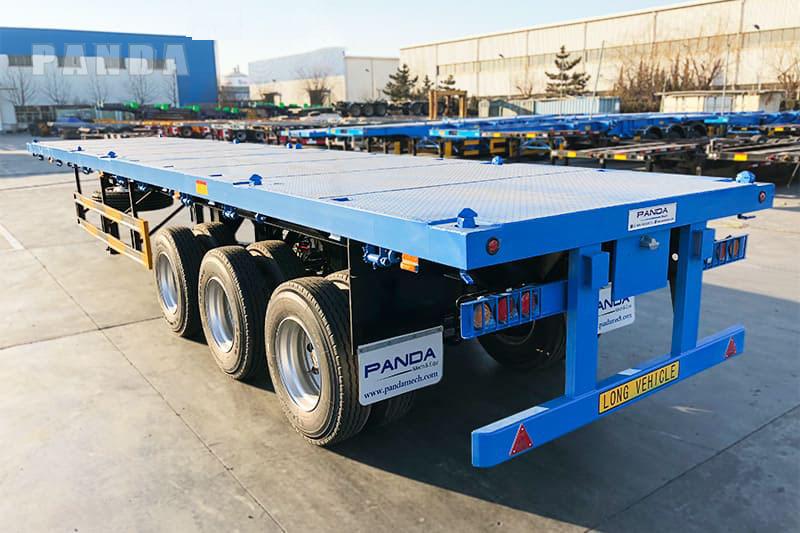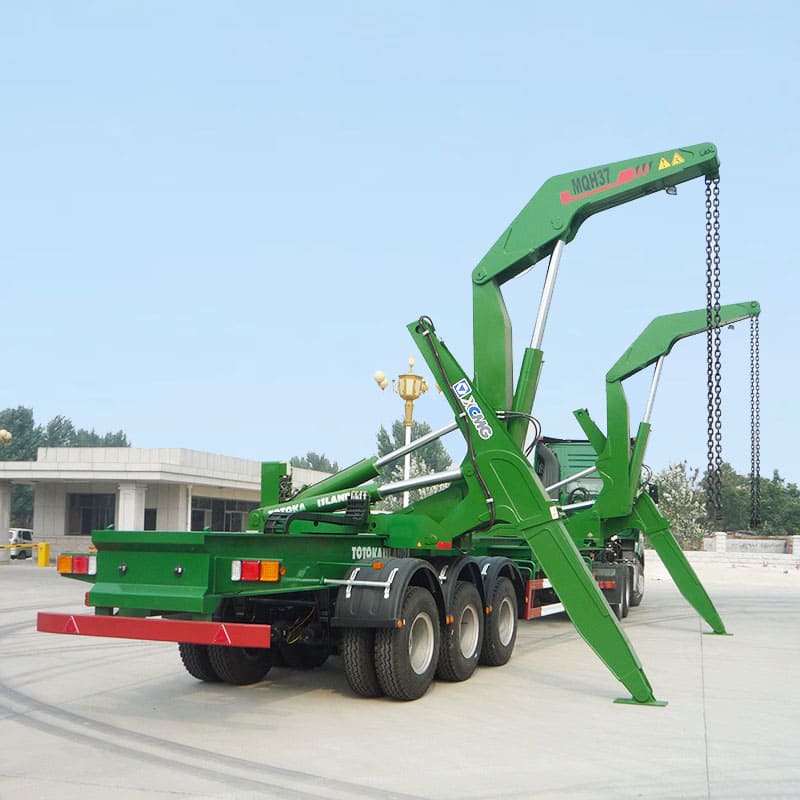Asphalt tanker trailers, also called bitumen tankers, are special semi-trailers, which are composed of trailer chassis, pump, tank body, burner, and heating system. Rockwool is used for insulation inside, and a stainless steel surface covers the outside of the asphalt tanker body. This makes asphalt tanker trailers durable and high quality.
Let us look at these asphalt tanker trailers in more detail.
Part1. What is an Asphalt Tanker Trailer?
Asphalt semi-trailers are used for moving liquid asphalt from one place to another. These trailers use diesel or gas burners to heat or insulate the liquid during transportation. Additionally, asphalt tankers are used for paving roads and treating asphalt surfaces.
These tankers also play a role in superficially paving and add another treatment layer on the surface in the plant-mixed black gravel road. Some trailers are designed to unload themselves using the inclination angle designed for the purpose. The angle is about 17 degrees, which helps the trailers to unload automatically at certain destinations. Moreover, the heaters blow air continuously to heat and insulate the asphalt in place automatically. These semi-trailers are ideal for the transportation of asphalt.

When we look at an oil asphalt tank, the heat transfer uses an organic heat-carrying agent. The heating agent uses coal-fired, oil-fired, or a coal-fired source to maintain the required temperature inside the trailer. The asphalt tanker trailer is low-pressure, safe, high-temperature, and sanitary, keeping the material safe and untethered during transportation.
The temperature can be controlled while transferring the asphalt from a larger trailer to a smaller tank without overheating the entire tank. Large-scale industries and factories use asphalt tanker trailers to transport huge amounts easily and quickly. Bitumen tanker trailers are with 2 to 4 axles and the tank body is designed differently. The design of the bitumen tank body is according to different steel needs and desired thickness.
1.1 How is bitumen transported
Bitumen, a heavy, semisolid form of petroleum, can typically be transported by three primary means: pipelines, truck trailers, or rail cars.
Bitumen pipeline: When bitumen is thinned enough, as with the addition of diluents such as condensate, it can typically be transported through a heavies pipeline. Pipelines are an efficient way to transport bitumen across large distances directly from the refining plant to donees. They contribute to better control and extra security.

Bitumen truck trailers: Where pipelines don’t reach, mainly for short distances road transportation is cheaper and gives the ability to cover areas far from national transport system pipes. Also, ripped bitumen can complete its hardening process in targeted locations reducing downstream problems and adversary environmental effects.
Bitumen rail cars: In regions where pipeline capacity may be constrained, bitumen might be transported via rail. In colder climates, these cars may need to be insulated or heated.

In certain scenarios, bitumen can also move by ship. Many companies liquefy the bitumen at specialized yards and later, the liquid form is moved inside ships after being sealed into secure containers, where it resets into the semisolid state at its destination.
The chosen method often depends on additional factors such as location, terrain, infrastructure, government regulation, safety considerations, etc.
Part2. What is the Principle of Asphalt Tanker?
The asphalt tank is principally used for heating the asphalt to keep it usable upon arrival at the destination. The tank circulates the heat using a hot oil pump to maintain different sets of asphalt temperatures. The temperature must be held in the tanker to keep the properties and performance of the asphalt intact.t.
The heating time is another essential thing to check. If it is heated for too long and at higher temperatures, the quality of the asphalt reduces considerably. This influences the performance and properties of the asphalt, directly affecting the quality of the project. Over 180°C, the asphalt starts to decompose.
The asphalt breaks down to free carbon that affects the purpose of the asphalt for any given project. Asphalt is cohesive and ductile, but carbides’ precipitation spoils it considerably once the proportion of free carbon increases. The performance and properties of asphalt are thereby reduced.
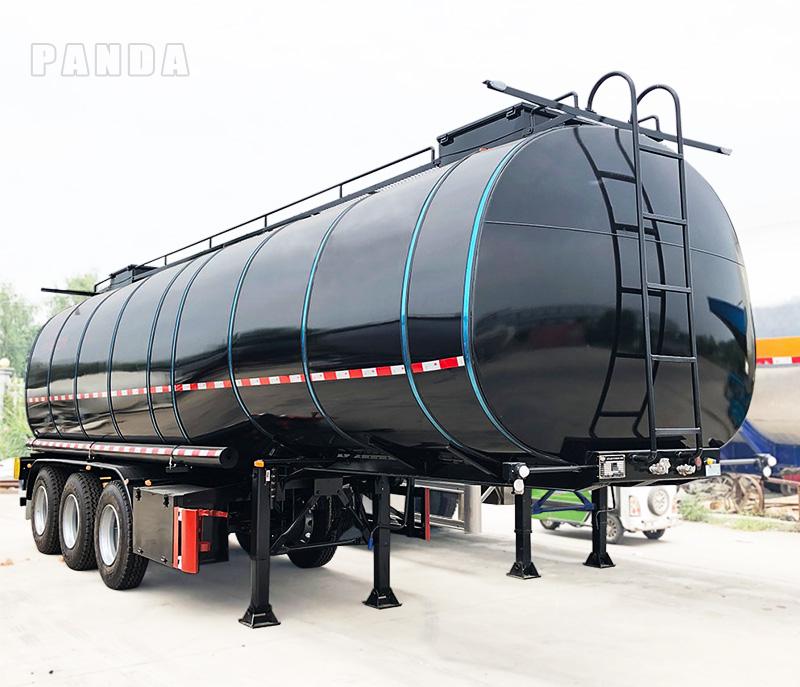
Part3. How to Operate an Asphalt Tanker?
Operating an asphalt tanker is not an easy task. The drivers are well trained and experienced before taking on long journeys of transporting liquid asphalt. Safe handling by end workers and tanker-truck drivers is of high importance. The high temperature of the asphalt and driving hazards in different climate conditions pose a challenge.
The asphalt tank must go through proper inspection before loading. The tank should be clean of debris and other contaminants. In case there is moisture in the tank, the asphalt mixed into it will cause foaming. This foam, when formed, may cause harmful fumes to leave the tank and the operator will be affected.
Part4. How to Load and Unload Asphalt?
Loading
The following are several things that all operators need to keep in mind when loading asphalt into the tank of the trailer.
- Ensuring that the chain covers are in the right places on the rotating drives so there is no chance of entanglement.
- The combustion sources are well-lit and nowhere near open manholes or overflow vents. This ensures there are no fire hazards.
- The distributor motor is on before the value is opened.
- Before opening the storage tank, the loading hose must be attached properly and the bleeder valve should be closed.
- Ensure that no one is standing close to the valves, which may open. This is an added safety measure.
- Once everything is in place, open the valve on the storage tank and pump the desired amount of asphalt at a slow rate. This rate should be appropriate, neither too high nor too low.
- Once the asphalt fills the tank, the storage valve and the bleeder valve are closed. The pump must continue to work so that all asphalt residue is out of the hose.
- The tank must have enough space for the expansion of the asphalt when it is heated.
- Once the hose clears all asphalt residue, it is disconnected and stored properly. The bleeder valve is closed and locked.
- The asphalt levels on the tank and gauges must also be checked to ensure sufficient quantity is loaded in the tank.

Unloading
While unloading asphalt from its tank, the operator must ensure that the chain covers are in their right place to avoid entangling. The sources of lit combustion must be clear of overflowing asphalt to prevent any fire hazards. Other things to keep in mind during unloading are:
- Checking whether the storage tank has sufficient capacity.
- The unloading pipe is attached to the truck, and the bleeder valve is closed. Once this is in place, the operator will unlock the storage tank.
- The valve of the storage tank pump is opened and the desired amount is filled at the right rate.
- Once the unloading is completed, the distributor adjustments are made following the operations manual, and the valve is closed.
- Every operator must follow the unloading instructions according to the model of the sucking pipe. The pipe must be cleared of any asphalt residue by the bleeder valve.
- Once all the steps are finished properly, the pipe should be disconnected from the distributor and placed back in its storage place. The valve on the tank must be locked and the bleeder valve closed.
Part5. How to Heat the Asphalt Tanker?
A tanker carrying asphalt is usually insulated with a heating device as it is used for carrying bitumen. There are several types of insulated tank trailers used for transporting different materials.
There is water present in the asphalt tanker trailers, and if that contains a colored binder, the temperature at the top should be 100 degrees. Once the dehydration cycle starts, it is important to maintain this temperature. Once the tank level thermometer falls below that position, the suction valve is closed so the water does not flow back due to heating.

The exhaust present in the heating tank is opened by a valve that allows the asphalt to enter the heater smoothly. Before the ignition, the tank is filled with water. Once the water is filled, the valve is opened, and the valve is closed once the desired height is reached.
In the process of heating, the operators should follow the instructions of the pump and that of the thermometer and make it on time safely. The asphalt should be pumped at a high temperature during the dehydration time. In case the temperature is too high, the internal circulation cooling should be started immediately in order to maintain the right temperature. Asphalt heating tanks should be operated with the relevant principles.
Part6. How do you keep the asphalt tanker insulated, and what is the insulation material?
The insulation material used in asphalt tankers is rock-mineral cotton and polyurethane. The pipeline is placed at the bottom of the tank for heating. This design makes the heat loss rate different in all trailer parts. The operator needs to follow several steps to keep the asphalt taker insulated.
The use of an insulated tanker in transport is essential. Industries rely on special vehicles to transport sulfur, asphalt, bitumen, and liquid phenol. The trailer has a long heat preservation duration. The drivers and operators need to install heating tubes in the tanks. Three types of heating modes are used in most insulated trailers.
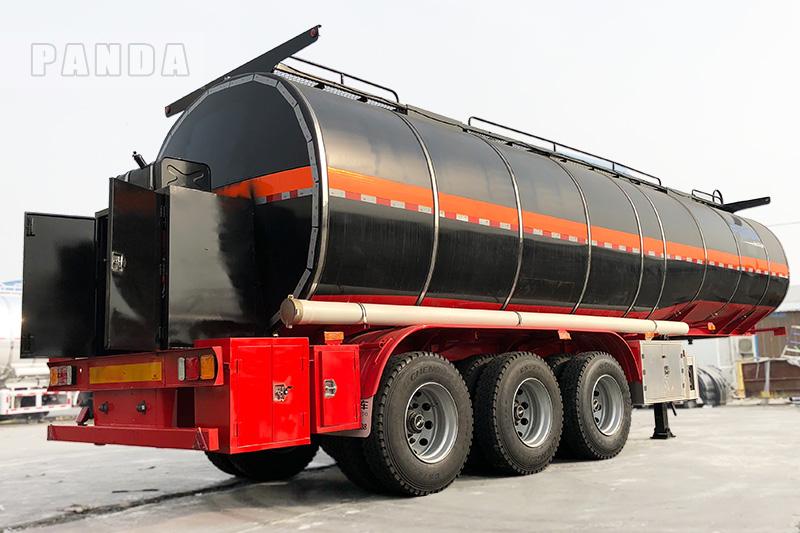
The heating modes are coal, steam, and diesel burners. Asphalt in the liquid state is transported at higher temperatures of about 250. Although such temperatures are supported through specialized means, all tanks are insulated to ensure the heat does not escape. With high temperatures, the complexities of the expansion of asphalt happen during transportation. The tank heating system takes care of this difference to maintain the quality of the asphalt.
Part7. What should be done if the asphalt solidifies in the tanker?
Asphalt is commonly used to bind gravel; the main ingredient is bitumen, which is made from processing petroleum. It can also be found in the natural environment. Asphalt is used in many places, such as road construction and paving sidewalks.
Sometimes, the asphalt solidifies in the tanker. The adhesive properties of bitumen make it tough work to get rid of it. But it is possible to dissolve the excess. Turpentine works on solid asphalt is like water works on the sand. The best way to clean a tank is to pour turpentine over the solidified areas and allow it to soak.
If the asphalt has solidified for a few days, it should soak for two to three days. If this happened recently, little time would be needed to get it off. Using protective gloves while handling the cleaning is essential to prevent health hazards.

Part8. How to Clean Asphalt Tank Trailer?
The process of cleaning an asphalt tank trailer is a lengthy one. First, flush the tank with hot water at high speed to remove all residue from the tanker. By this no matter what hard and solidified asphalt will dislocate from its location. After that, detergent is flushed into the tanker to clean all contamination and ensure that all residue is freed from the tanker. Finally, the tanker is flushed with hot water again to remove detergent from the tanker. All detritus is removed from the tanker trailer this way.

Part9. How to Extinguish an Asphalt Tanker Fire
It is not easy to extinguish the fire of an asphalt tanker trailer. In order to prevent accidents, operators and drivers should take sufficient precautions. The operators and drivers must have fire extinguishers handy in case of fire. These are usually available in the trailers to ensure that the fire does not spread.
First, make the vehicle empty and use the extinguishers properly. If the tanker is filled with asphalt, the fire will not go out with just fire extinguishers. The driver must clean up the surrounding areas and call for help immediately. Professional firefighters can do the job if called at the earliest.
Part10. How Much does the Asphalt Tanker Cost?
The current price of an Asphalt tanker is around USD 25,000 to $39,000. Manufacturers make quotes according to different sizes and specifications.

Part11. About Bitumen Tanker Trailer
The different heating system of bitumen tank trailers makes it a unique choice for certain liquid transportation. The heating system includes 1 or 2 burners, pumps, generators and diesel engines, depending on the size of the tank body. This unique feature allows asphalt to be heated and ready for use as arriving at the destination. There are different standards worldwide, but the maximum load capacity of asphalt tanker is 60,000 liters. Some countries allow as much as 22,000 liters, but that also varies for road and sea transportation.
Part11. Best-selling fuel tanker recommended
1. 38,000L Asphalt Tanker Trailer With Burner

2. 42000 Liters Hot Oil Asphalt Trailers
We are a 42000 Liter liquid asphalt tanker manufacturer from China. We supply 42000 Liters liquid asphalt tanker for sale. We can customize it according to your needs.
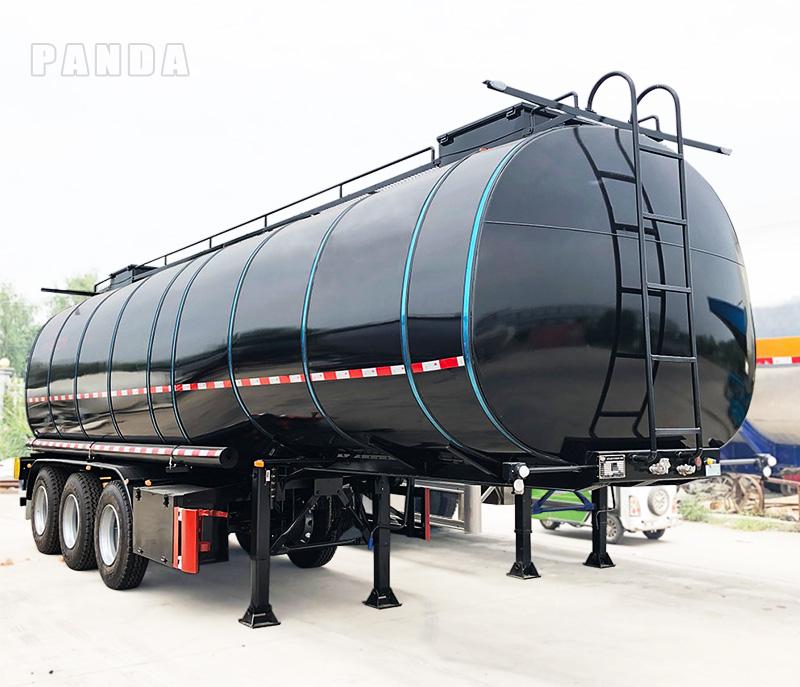
3. 60,000 liters Bitumen Trailer
Panda Mech is a bitumen tanker trailer manufacturer from China. We provide 60000 liters and more bitumen tanker trailers for sale. We can customize it according to your needs.

CONCLUSION:
If you want to purchase asphalt tanker, or have questions about the bitumen tanker trailer types, then leave message for us. PANDA MECH is your best choice. As a professional manufacturer with decades of production experience, we have provided various production solutions for tens of thousands of users at home and abroad. We can not only help you choose the asphalt tanker trailer that best suits your needs, we can also provide comprehensive after-sales service, whether it is about the operation, repair, and maintenance of the bitumen tanker.

